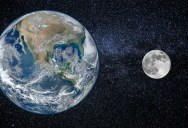The Moon And Earth Are Slowly Drifting Apart, But It’s Impossible For Us To Ever Break Up For Good

The moon is a constant in our world.
It’s always there, or always coming back in a few hours, and we can track our days and nights but its shape and how long it hangs in the sky.
It is moving away from us, though – but could it ever get far enough to escape our gravity and float away entirely?
The quick (and relieving) answer is no.

The Moon was first created 4.5 billion years ago, probably when a planet named Theia collided with Earth.
The two orbits have changed over time, with the Moon slowly getting further and further away. This is the reason that one day we won’t ever see another solar eclipse again, says NASA’s Goddard Space Flight Center lunar scientist Richard Vondrak.
“Over time, the number and frequency of total solar eclipses will decrease. About 600 million years from now, Earth will experience the beauty and drama of a total solar eclipse for the last time.”
Thanks to the Lunar Laser Ranging Experiment and the reflectors placed on the Moon’s surface by the Apollo missions, we know exactly how quickly it’s happening, too.

Scientists can measure the distance between the two points to within 3 centimeters, and they say the Moon is currently moving away at a rate of about 3.8 centimeters a year.
It will never drift out of our orbit entirely, however.
We will go down together when the Sun eventually becomes a red giant and swallows us whole.
If you thought that was interesting, you might like to read about a second giant hole has opened up on the sun’s surface. Here’s what it means.

Sign up to get our BEST stories of the week straight to your inbox.




